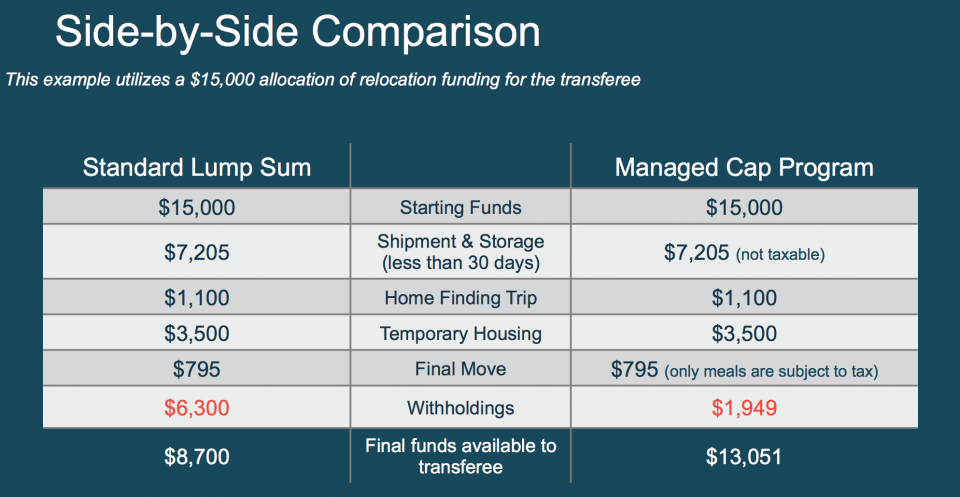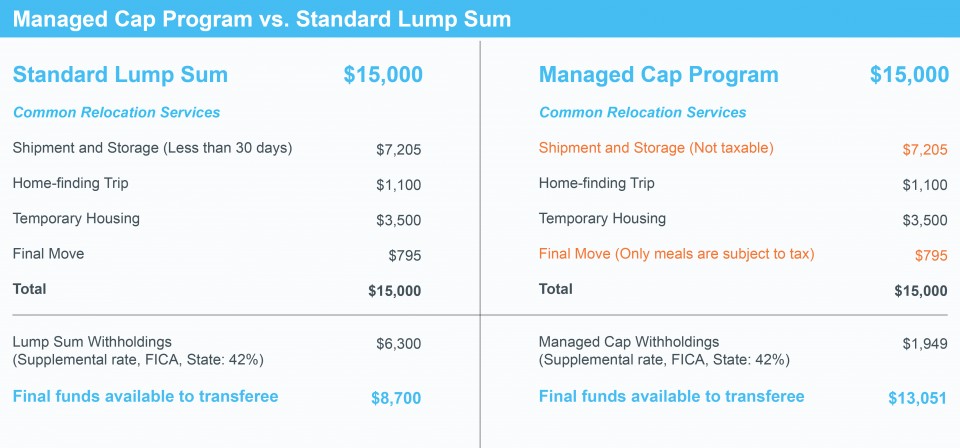Global Mobility Solutions recently surveyed its clients to determine the impact of lump sum relocation packages on their organizations. Industry trends arising this year are having a direct impact on transferees. Often these trends become visible through the use of business intelligence and data analytics.
What are Lump Sum Relocation Packages?
Lump sum relocation packages are a specific amount of money that employers offer to transferees or new hires. This money replaces a number of relocation benefits such as household goods moves, culture and language training, or home-finding assistance. Essentially, employers expect employees receiving a lump sum payment to manage their own relocation process.
Advantages of Lump Sum Relocation Packages
Simplification
The advantages of lump sum relocation packages are related to helping employers simplify the process. The main advantage is that employers and their mobility managers have less complications around relocation support. Providing support during an employee’s relocation is reduced to answering questions about when the lump sum funds will be available.
Budgeting and Forecasting
Another simplification for employers revolves around budgeting and forecasting. Instead of working to understand the true costs of hiring new employees or transferring employees from one location to another, the budget process is tied to a number that is applied across the board based on tiers in the relocation program. An executive homeowner with a family relocating from Duluth, MN, to New York, NY is given the same lump sum payment as another single executive renter who is relocating from Las Vegas, NV, to Fort Wayne, IN. The renter will pocket a significant amount of money. However, the homeowner will not have enough funds to cover the costs of moving their family.
Disadvantages of Lump Sum Relocation Packages
Inadequate Coverage
Lump sum relocation packages make things easier for employers when it comes to administration and budgeting. However, there are several disadvantages employers are beginning to see in their organizations. First among these disadvantages are that many lump sum payments do not adequately cover all of an employee’s relocation costs. GMS’ 2019 Lump Sum Survey shows that employees are spending more, and sometimes significantly more, on their relocation than their lump sum payment. This includes:
- 61 % of homeowners reporting spending more
- 50% of renters reporting spending more
Employee Dissatisfaction
Ultimately, more than half of relocating employees do not receive enough lump sum cash to cover their expenses. Naturally, this results in a higher level of dissatisfaction with the organization’s lump sum relocation packages. Overall, dissatisfaction with lump sum payments follows these patterns:
- 58% of homeowners reporting dissatisfaction
- 53% of renters reporting dissatisfaction
Loss of Control
A significant disadvantage is the employer’s loss of control over how budget dollars are spent. Lump sum relocation packages disbursed directly to employees may result in company funds being spent on non-relocation expenses including cars, televisions, vacations, or any number of items. Funds spent on non-relocation expenses do not support the successful relocation of the employee. As a result, the relocation may be at higher risk of failure.
Inefficiencies
Many GMS clients achieve significant spending reductions with relocation programs that follow industry best practices. A major GMS client recently conducted an in-depth study of their relocation program expenses. This client learned that if their organization moved to a lump sum program, they might increase their relocation program expenses by 40%. In other words, by following industry best practices, this client keeps relocation budget dollars that otherwise would have been spent on inefficient lump sum relocation packages. Any GMS client can achieve the same reduction in relocation costs through:
- Benchmarking their relocation policy to industry best practices
- Efficient relocation program operation
- Providing support to transferees that they actually need
- Using business intelligence and data analytics to understand the true costs of their relocation program
- Utilizing a competitive vendor network of relocation service providers
What Does This Mean?
Companies that offer lump sum relocation packages could potentially save a significant amount of budget dollars by following industry best practices. Lump sum payments let employers simplify their internal processes related to support, budgeting, and forecasting. However, this simplification may be costing employers up to 40% or more of their relocation budget dollars. It also results in over half of transferees reporting dissatisfaction with their relocation packages.
What Should Employers do About Lump Sum Relocation Packages?
Employers with transferees or new hires that are recent college graduates, individual contributors, or new to their professional career may be the best candidates for lump sum relocation packages. These employees are often renters and may not have a significant amount of household goods to move to a new location. Also, they tend to not require a significant investment in talent acquisition, as they compete for lower tier positions.
For employers who have new hires and transferees at higher tiers, industry best practice is to provide a range of benefits. Employees at higher tiers often require a significant investment in talent acquisition. Benefits that help ensure successful relocations also result in higher employee satisfaction.
Industry Benchmarking Studies Help Employers Compare Their Relocation Program
GMS has recently published several Industry Benchmarking Studies to help employers learn whether their company’s relocation program is designed following industry-specific best practices. There are many benefits to a corporate relocation policy benchmarking. For example, employers can learn how lump sum relocation packages in their relocation program compare to those offered by competitors in their specific industry.
Industry best practice is to schedule a relocation program and policy review every 12 to 18 months to ensure your company maintains its competitive position. This review will also help your company learn about how the relocation industry is evolving to meet increased employee demands, including recently evolving trends for lump sum relocation packages.
Conclusion
GMS’ team of corporate relocation experts has helped thousands of our clients understand how to create relocation policies that attract and retain talent. Our team can help your company provide the best experience for transferees and new hires who have lump sum relocation packages.
GMS was the first relocation company to register as a .com. The company also created the first online interactive tools and calculators, and revolutionized the entire relocation industry. GMS continues to set the industry pace as the pioneer in innovation and technology solutions with its proprietary MyRelocation™ technology platform.
Global Mobility Solutions is proud to be named and ranked #1 Overall, and #1 in Quality of Service by HRO Today’s 2019 Baker’s Dozen Customer Satisfaction Survey.
Contact our experts online to discuss how your company can leverage lump sum relocation packages for new hires and transferees, or give us a call at 800.617.1904 or 480.922.0700 today.
We're Here to Help! Request a Courtesy Consultation
Are you ready to talk to a Mobility Pro? Learn how GMS can optimize your mobility program, enhance your policies to meet today’s unique challenges, receive an in-depth industry benchmark, or simply ask us a question. Your Mobility Pro will be in touch within 1 business day for a no-pressure, courtesy consultation.












